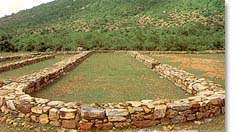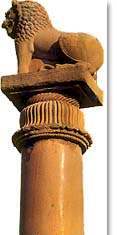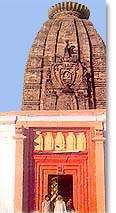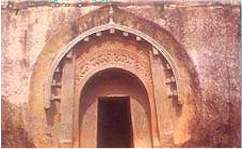India > Forts & Monuments > Bihar
BIHAR
Nalanda University
The ruins of Nalanda university is spread over an area of 14 hectares. This university was totally built in Red clay bricks. The Nalanda university attracted scholars from all over the world. Even Chanakya or Kautilya was once a student of this university. This university was seat of knowledge for the world, the light of knowledge spread all over the world from Nalanda. Today only the memories of those glorious days are refreshed in the ruins. Whatever remains of the great university has been well preserved. Among the ruins one still recognizes the different sections of the place. Particularly the place of worship and the hostels are very distinct. The whole area is surrounded by beautiful lawns.
At the excavation site, visitors going in for the monasteries and temples stand at the eastern gate. The tourists going in for university ruins enter the site from the Western gate. The main temple area No. 3 is situated on the southern side of the site. The temple is surrounded by many small Stupas in a courtyard. The Vihar area no. 1 is the most important at this place. This Vihar has 9 storeys. The various levels are identified by the concrete courtyards and the walls & drains which are built one over the other. It is believed that the lower most Vihar was built by Devapal, the third king of the Pala dynasty.
Fort of King Vishal, Vaishali
This one kilometer long fort is said to have housed the parliament of those times. This fort is named after King Vishal. The fort was a part of the oldest democracy in the world. The construction of this fort is worth giving a look. Apart from the fort, the museum of Vaishali is worth visiting. This museum has some of the excavated artifacts from Vaishali. Then there are the Stupas, Abhishek Pushkarni and the Dargah of Miranji are some of the tourist places in Vaishali. The stupas found in Vaishali had stone caskets which contained the ashes of Buddha. About the Abhishek Pushkarni is said that a king anoint with the water of this tank before his coronation.
Rajgir, Nalanda

Rajgir, in district Nalanda, is a great holy place of the Buddhists. It is the ancient Rajagriha, the capital of the ancient kingdom of Magadha. During the days of Mahavira and Buddha, who visited it very often, it was a very flourishing city. It was the venue of the First Buddhist council held immediately after the Nirvana of Buddha, during the time of king Ajatshatru.
Partly excavated ruins of Rajgir cover an extensive area within and outside the hill enclosure and include the ancient defense and remains of habitations, shrines, stupas and monasteries. A monastery with large elliptical halls has been recently excavated and identified as Jeevak Amravan mentioned in the Buddhist texts.
Vaishali

Once the capital of the Lichcavis, Vaishali is one of the oldest Republics of the world. It was here that Buddha preached his last sermon and announced his approaching 'nirvana'. It became the venue for the 2nd Buddhist council a hundred years later. King Ashoka erected a commemorative pillar at Kolhua to mark this place.
Vaishali is also a place of great religious importance to the Jains, as Lord Mahavira was born and preached his doctrine here. He was the 24th tirthankar. Vaishali's notable monuments are (i) Lion Pillar of Ashoka (ii) Raja Vaishala ka Garh (iii) Lotus tank (iv) Barvan Pokhar temple (v) Jain temple (vi) Hari Katora and (vii) Buddhist Stupas.
Rohatasgarh Fort

39 km from Sasaram are the remains of Sher Shah Suri's Rohtasgarh fort, It now occupies a part of the plateau about 4 miles east to west and 5 miles north to south, 28 miles in circumference. It is considered one of the largest and strongest hill forts in India. This fort served as a safe shelter for treasures and families of Sher Shash Suri, Shah Jehan, Maan singh, Mir Uasim (and others during the revolt of 1857). Records suggest that there are 84 passages to the hill with 14 main gates entry. However Sher Shah closed ten of them.
Deo
Situated on the National Highway No. 2 and 150 km from Patna near Aurangabad, Deo is the most ancient of all sites where the legendary king Alia of Prayaga (Allahabad) was cured of leprosy. Here stands a beautifully ornamented sun temple housing an image of the deity in its sanctum. The tower bears fiery symbols of surya besides figures of the other deities. The temple, unlike traditional sun temples, faces the west.
Barabar Caves
The Barabar and Nagarjuni Hills are situated about 25 km north of Gaya and contain, in all, seven rock cut caves of which four are in the Barabar hills. Two of the caves, dedicated by Ashoka to Ajivika monks, are in the form of a plain rectangular outer hall. At one end of which is an inner chamber with carved wall and over hanging caves.

The Karan Chaupa cave - the entire interior of the cave, excluding the platform, bears a high polish. The entrance is in 'Egyptian form'.
The Sudama cave - The cave entrance is in 'Egyptian form' and consists of two chambers. The Lomas.
The Rishi cave - The entrance is in 'Egyptian form' and only walls of the outer rooms are polished.
The Visa Zopri cave - Consists of an outer apartment, bearing the high polish on its walls and flat roof. On the right hand wall, is an inscription record.
Lauria Nandangarh

23 km from Bettiah are the remains of huge stupa called Nandangarh. This 26 metre high mound is composed of brick s and is conjectured to be Ashes stupa, the stupa in which ashes of the Lord Buddha were enshrined.
At Lauria Nandangarh stands the famous pillar of Ashoka - an 8.5 m single block of polished sandstone bearing an edict of the emperor.
Munger Fort
The most famous and important of the monuments at Munger is the fort, built on a rocky eminence projecting into the river Ganga which protects it from west and partly from the north, the other sides being defended by a deep moat. The fort encloses an area of about 222 acres and has a circuit of 4 km. It was built during the time of the early, Mohammedan kings of India.

